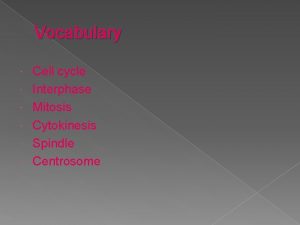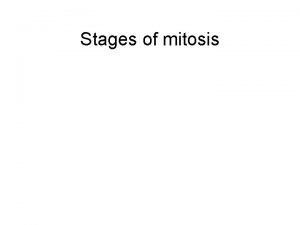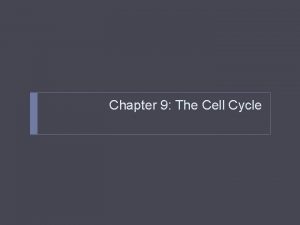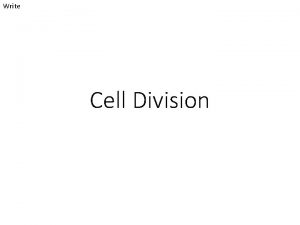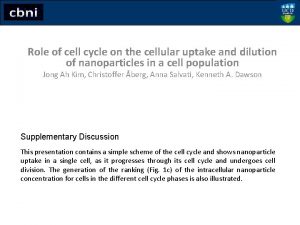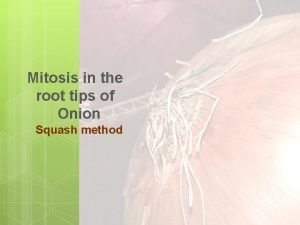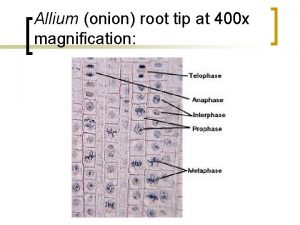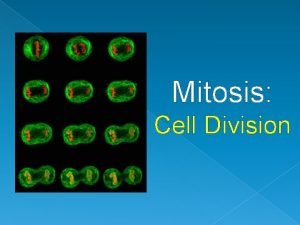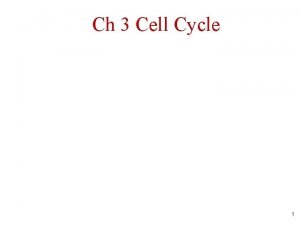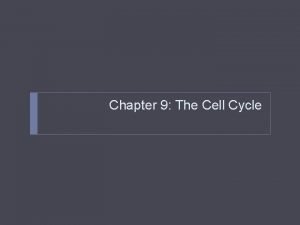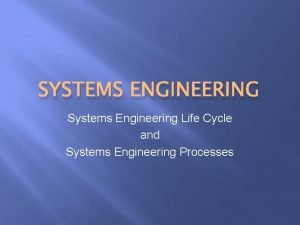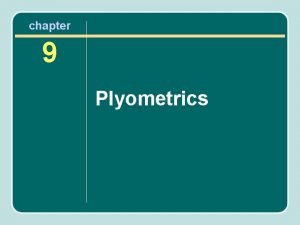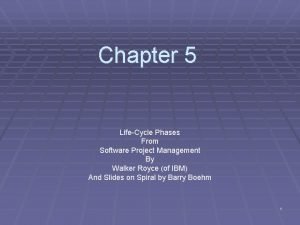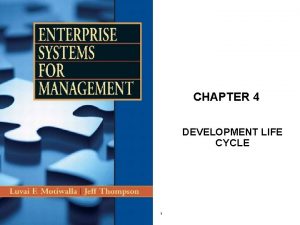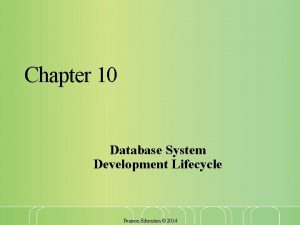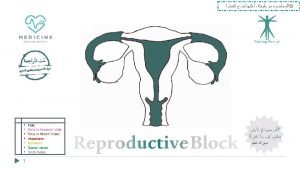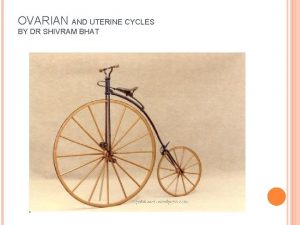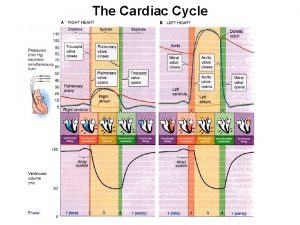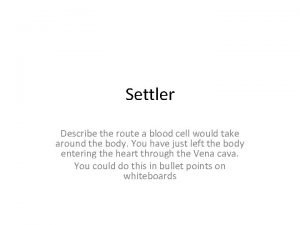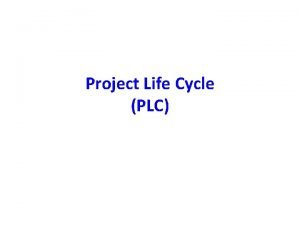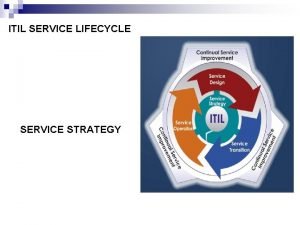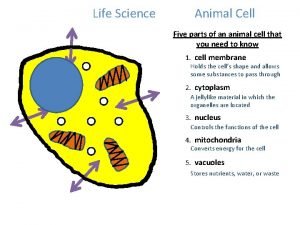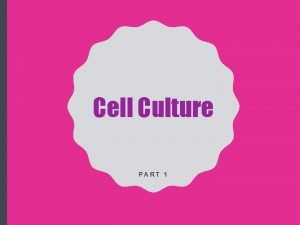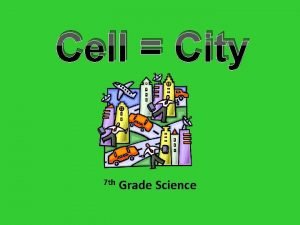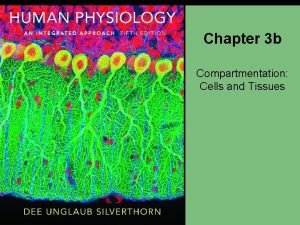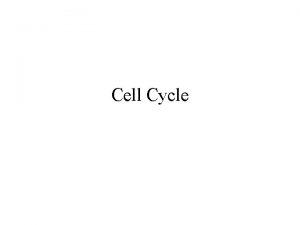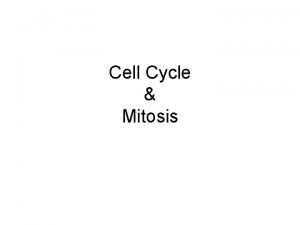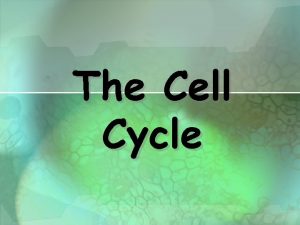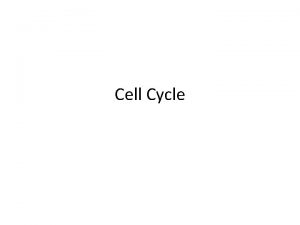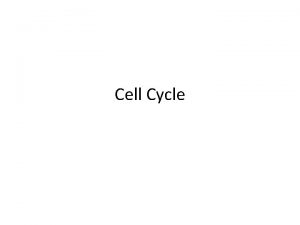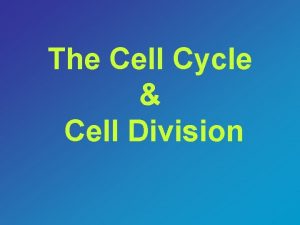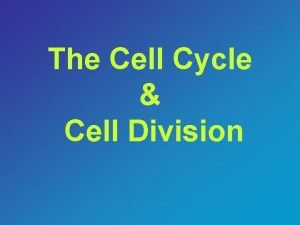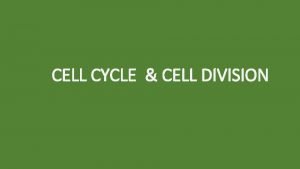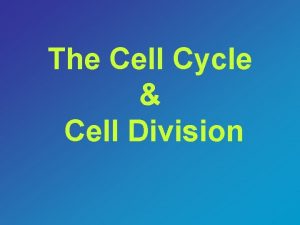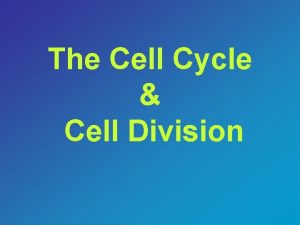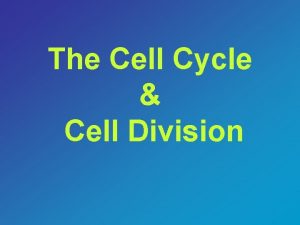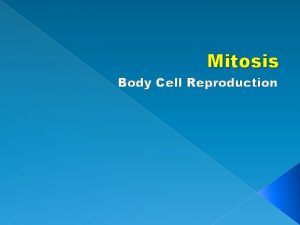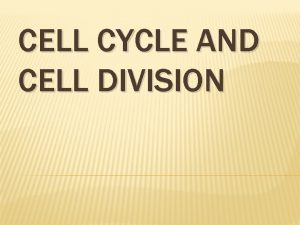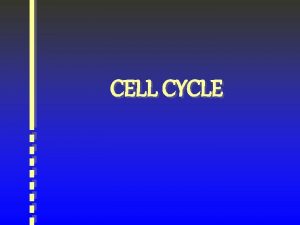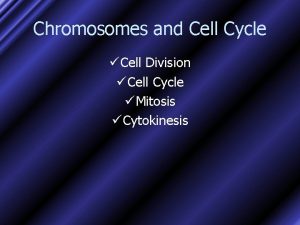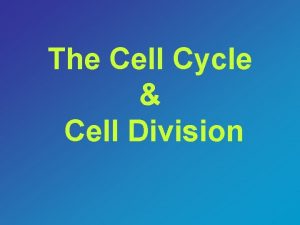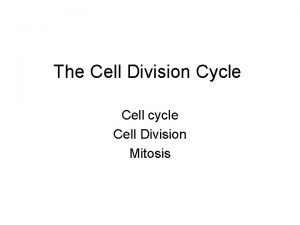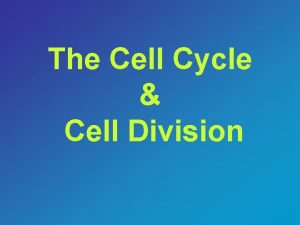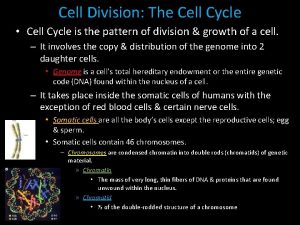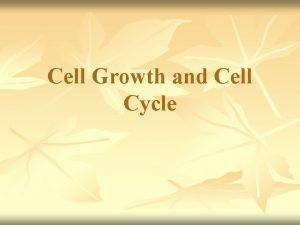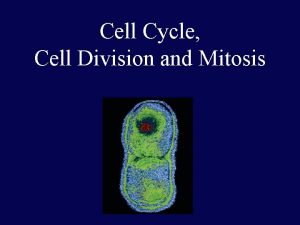The Cell Cycle 1 Five Phases of the




























































- Slides: 60

The Cell Cycle 1

Five Phases of the Cell Cycle üG 1 - primary growth phase üS – synthesis; DNA replicated üG 2 - secondary growth phase collectively these 3 stages are called interphase üM - mitosis üC - cytokinesis 2

Cell Cycle 3

Interphase - G 1 Stage ü 1 st growth stage after cell division üCells mature by making more cytoplasm & organelles üCell carries on its normal metabolic activities 4

Interphase – S Stage üSynthesis stage üDNA is copied or replicated Two identical copies of DNA Original DNA 5

Interphase – G 2 Stage ü 2 nd Growth Stage üOccurs after DNA has been copied üAll cell structures needed for division are made (e. g. centrioles) üBoth organelles & proteins are synthesized 6

Sketch the Cell Cycle DNA Copied Cells Mature Daughter Cells prepare for Division Cell Divides into Identical cells 7

Cells divide at different rates • Prokaryotic and eukaryotic cell division is similar but because prokaryotes do not have membrane bound organelles, their cell division happens much faster. 8

Cell Size is Limited • Cells have upper and lower limits • The lower limit is because cells need space for all their organelles to perform their duties • The upper limit is because cells need to sustain themselves 9

Mitosis 10

Mitosis üDivision of the nucleus üOnly occurs in eukaryotes üHas four stages üDoesn’t occur in some cells such as brain cells 11

Four Mitotic Stages üProphase üMetaphase üAnaphase üTelophase 12

Early Prophase üChromatin in nucleus condenses to form visible chromosomes üMitotic spindle forms from fibers in cytoskeleton or centrioles (animal) Nucleolus Chromosomes Cytoplasm Nuclear Membrane 13

Late Prophase üNuclear membrane & nucleolus are broken down üChromosomes continue condensing & are clearly visible üSpindle fibers called kinetochores attach to the centromere of each chromosome üSpindle finishes forming between the poles of the cell 14

Spindle Fiber attached to Chromosome Kinetochore Fiber Chromosome 15

Review of Prophase What the cell looks like What’s happening 16

Spindle Fibers üThe mitotic spindle form from the microtubules in plants and centrioles in animal cells üPolar fibers extend from one pole of the cell to the opposite pole üKinetochore fibers extend from the pole to the centromere of the chromosome to which they attach üAsters are short fibers radiating from centrioles 17

Sketch The Spindle 18

Metaphase üChromosomes, attached to the kinetochore fibers, move to the center of the cell üChromosomes are now lined up at the equator Equator of Cell Pole of the Cell 19

Metaphase Asters at the poles Spindle Fibers Chromosomes lined at the Equator 20

Metaphase Aster Chromosomes at Equator 21

Review of Metaphase What the cell looks like What’s occurring 22

Anaphase üOccurs rapidly üSister chromatids are pulled apart to opposite poles of the cell by kinetochore fibers 23

Anaphase Sister Chromatids being separated 24

Anaphase Review What the cell looks like What’s occurring 25

Telophase üSister chromatids at opposite poles üSpindle disassembles üNuclear envelope forms around each set of sister chromatids üNucleolus reappears üCYTOKINESIS occurs üChromosomes reappear as chromatin 26

Comparison of Anaphase & Telophase 27

Cytokinesis üMeans division of the cytoplasm üDivision of cell into two, identical halves called daughter cells üIn plant cells, cell plate forms at the equator to divide cell üIn animal cells, cleavage furrow forms to split cell 28

Cytokinesis Cleavage furrow in animal cell Cell plate in animal cell 29

Daughter Cells of Mitosis üHave the same number of chromosomes as each other and as the parent cell from which they were formed üIdentical to each other, but smaller than parent cell üMust grow in size to become mature cells (G 1 of Interphase) 30

Identical Daughter Cells What is the 2 n or diploid number? 2 Chromosome number the same, but cells smaller than parent cell 31

Uncontrolled Mitosis ü If mitosis is not controlled, unlimited cell division occurs causing cancerous tumors ü Oncogenes are special proteins that increase the chance that a normal cell develops into a tumor cell Cancer cells 32

Meiosis Formation of Gametes (Eggs & Sperm) 33

Facts About Meiosis üPreceded by interphase which includes chromosome replication üTwo meiotic divisions --- Meiosis I and Meiosis II üCalled Reduction- division üOriginal cell is diploid (2 n) üFour daughter cells produced that are haploid (1 n) 34

Facts About Meiosis üDaughter cells contain half the number of chromosomes as the original cell üProduces gametes (eggs & sperm) üOccurs in the testes in males (Spermatogenesis) üOccurs in the ovaries in females (Oogenesis) 35

More Meiosis Facts ü Start with 46 double stranded chromosomes (2 n) üAfter 1 division - 23 double stranded chromosomes (n) üAfter 2 nd division - 23 single stranded chromosomes (n) ü Occurs in our germ cells that produce gametes 36

Why Do we Need Meiosis? üIt is the fundamental basis of sexual reproduction üTwo haploid (1 n) gametes are brought together through fertilization to form a diploid (2 n) zygote 37

Fertilization – “Putting it all together” 2 n = 6 1 n =3 38

Replication of Chromosomes ü Replication is the process of duplicating a chromosome ü Occurs prior to division ü Replicated copies are called sister chromatids ü Held together at centromere Occurs in Interphase 39

A Replicated Chromosome Gene X Homologs (same genes, different alleles) Sister Chromatids (same genes, same alleles) Homologs separate in meiosis I and therefore different alleles separate. 40

Meiosis Forms Haploid Gametes ü Meiosis must reduce the chromosome number by half ü Fertilization then restores the 2 n number from mom from dad child too much! meiosis reduces genetic content The right number! 41

Meiosis: Two Part Cell Division Sister chromatids separate Homologs separate Meiosis II Diploid Haploid 42

Meiosis I: Reduction Division Nucleus Early Late Prophase I (Chromosome Prophase I number doubled) Spindle fibers Nuclear envelope Metaphase Anaphase Telophase I I I (diploid) 43

Prophase I Early prophase üHomologs pair. üCrossing over occurs. Late prophase üChromosomes condense. üSpindle forms. üNuclear envelope fragments. 44

Tetrads Form in Prophase I Homologous chromosomes (each with sister chromatids) Join to form a TETRAD Called Synapsis 45

Crossing-Over ü Homologous chromosomes in a tetrad cross over each other ü Pieces of chromosomes or genes are exchanged ü Produces Genetic recombination in the offspring 46

Homologous Chromosomes During Crossing-Over 47

Crossing-Over Crossing-over multiplies the already huge number of different gamete types produced by independent assortment 48

Metaphase I Homologous pairs of chromosomes align along the equator of the cell 49

Anaphase I Homologs separate and move to opposite poles. Sister chromatids remain attached at their centromeres. 50

Telophase I Nuclear envelopes reassemble. Spindle disappears. Cytokinesis divides cell into two. 51

Meiosis II Gene X Only one homolog of each chromosome is present in the cell Sister chromatids carry identical genetic information. Meiosis II produces gametes with one copy of each chromosome and thus one copy of each gene. 52

Meiosis II: Reducing Chromosome Number Prophase II Metaphase II Telophase II Anaphase II 4 Identical haploid cells 53

Prophase II Nuclear envelope fragments. Spindle forms. 54

Metaphase II Chromosomes align along equator of cell. 55

Anaphase II Equator Pole Sister chromatids separate and move to opposite poles. 56

Telophase II Nuclear envelope assembles. Chromosomes decondense. Spindle disappears. Cytokinesis divides cell into two. 57

Results of Meiosis Gametes (egg & sperm) form Four haploid cells with one copy of each chromosome One allele of each gene Different combinations of alleles for different genes along the chromosome 58

Comparing Mitosis and Meiosis 59

Comparison of Divisions Mitosis Number of divisions Number of daughter cells Genetically identical? 1 Meiosis 2 2 4 Yes No Same as parent Half of parent Where Somatic cells Germ cells When Throughout life At sexual maturity Growth and repair Sexual reproduction Chromosome # Role 60
 Five phases of the cell cycle
Five phases of the cell cycle Cell cycle phases
Cell cycle phases Interphase
Interphase Cell cycle phases
Cell cycle phases Phases of mitosis
Phases of mitosis Steps of cell cycle
Steps of cell cycle Phases of the cell cycle
Phases of the cell cycle Section 10-2 cell division
Section 10-2 cell division Cell cycle and cell division
Cell cycle and cell division Biology.arizona.edu/cell bio/activities/cell cycle/01.html
Biology.arizona.edu/cell bio/activities/cell cycle/01.html Focused note taking process
Focused note taking process Squash method onion root tip
Squash method onion root tip Onion root tip cell size
Onion root tip cell size Mitosis in whitefish and onion roots
Mitosis in whitefish and onion roots Cell phases
Cell phases Cleavage furrow
Cleavage furrow Nasa project life-cycle process flow poster
Nasa project life-cycle process flow poster Systems engineering life cycle
Systems engineering life cycle Performance monitoring and coaching reflection
Performance monitoring and coaching reflection 8 stages of sdlc
8 stages of sdlc Phases of a business cycle
Phases of a business cycle Stretch shortening cycle phases
Stretch shortening cycle phases Construction phase in software engineering
Construction phase in software engineering Itil service transition definition
Itil service transition definition Embedded system development life cycle
Embedded system development life cycle Erp life cycle phases
Erp life cycle phases Database system life cycle
Database system life cycle Phases of uterine cycle
Phases of uterine cycle Corona radiata
Corona radiata Data analytics lifecycle example
Data analytics lifecycle example Kendall kendall
Kendall kendall Urutan sistole
Urutan sistole Atrial systole
Atrial systole Plc phases
Plc phases Expert system life cycle
Expert system life cycle Itil stages
Itil stages The sounding cataract haunted me
The sounding cataract haunted me One in five challenge
One in five challenge Five elements and five senses
Five elements and five senses Macbeth act five scene one
Macbeth act five scene one Five parts of a cell
Five parts of a cell 5 parts of an animal cell
5 parts of an animal cell Fashion cycle stages
Fashion cycle stages Golgi body school analogy
Golgi body school analogy Denuding tower
Denuding tower Site:slidetodoc.com
Site:slidetodoc.com Prokaryotic reproduction
Prokaryotic reproduction Venn diagram of plant and animal cells
Venn diagram of plant and animal cells Electrode concentration cell
Electrode concentration cell Dry cell vs wet cell
Dry cell vs wet cell Plant cell vs animal cell venn diagram
Plant cell vs animal cell venn diagram Cell wall function
Cell wall function Plant cell structure
Plant cell structure Plant cell structure and function
Plant cell structure and function Cell wall cell membrane
Cell wall cell membrane Cell line vs cell strain
Cell line vs cell strain Cell line vs cell strain
Cell line vs cell strain Cell city analogy answer key
Cell city analogy answer key Primary battery and secondary battery
Primary battery and secondary battery Difference between bacteria and plant cell
Difference between bacteria and plant cell Cell-cell junction
Cell-cell junction

